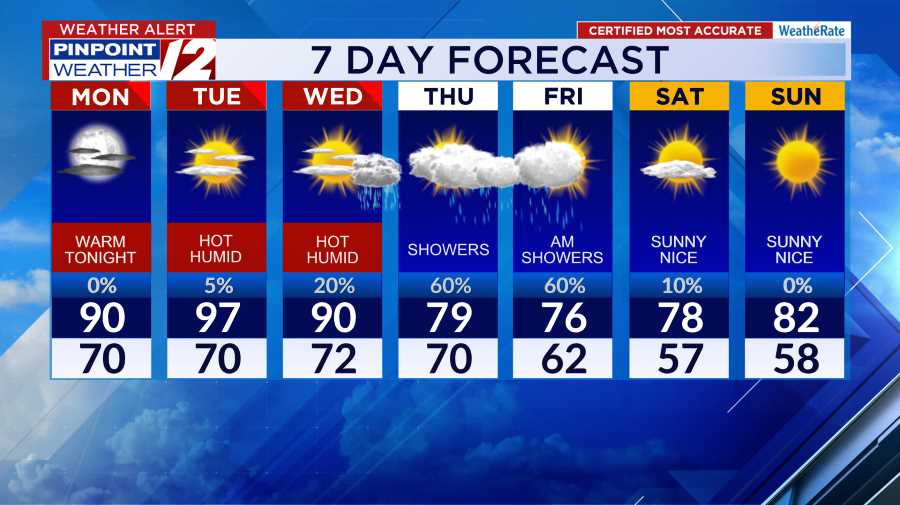(NEXSTAR) – Recent strong activity on the Sun has led to multiple appearances by the northern lights across much of the U.S. One recent geomagnetic storm even made the brilliant swathes of color visible as far south as Alabama, a rare occurrence that could become more common.
A geomagnetic storm powerful enough to send the northern lights into the very southern portions of the U.S. occurs about once every 11 years, according to the National Oceanic and Atmospheric Administration’s Space Weather Prediction Center.
The late April event that brought the aurora into the southern U.S. was sparked by a coronal mass ejection, or a CME, and a solar flare.
The current solar cycle, dubbed Solar Cycle 25, is to largely to thank for that. It began in December 2019, according to Rob Steenburgh, a space scientist with NOAA’s Space Weather Prediction Center. During this cycle, an 11-year period, the Sun will flip its magnetic poles and cause space weather, “variations in the space environment between the Sun and Earth,” which includes CMEs.
CMEs are explosions of plasma and magnetic material from the sun that can reach Earth in as little as 15 to 18 hours, NOAA explains. According to NASA, CMEs can create currents in Earth’s magnetic fields that send particles to the North and South Poles. When those particles interact with oxygen and nitrogen, they can create auroras.
“It’s essentially the Sun shooting a magnet out into space,” Bill Murtagh, program coordinator for the SWPC and seasoned space weather forecaster, tells Nexstar. “That magnet impacts Earth’s magnetic field and we get this big interaction.”
That interaction is known as a geomagnetic storm. The strength of the geomagnetic storm will impact how far south the northern lights will be visible.
As Murtagh explains, the SWPC uses a scale, similar to those used to measure tornadoes or hurricanes, to categorize the strength of a geomagnetic storm.
According to the scale, a minor G-1 storm leads to aurora commonly being visible in Maine and Michigan’s Upper Peninsula. A moderate G-2 storm can bring the northern lights slightly southward into New York and Idaho.
When a storm reaches G-3 status, aurora can be viewed as far south as Illinois and Oregon. Should it reach G-4 strength, those living in Alabama and northern California may have a chance at seeing the northern lights. Solar activity that causes a G-5 storm, the highest possible on SWPC’s scale, has been known to make aurora appear in Florida and even southern Texas.
One such storm in September 1859 – known as the Carrington Event, according to Murtagh – was so powerful, those living in Cuba, Central America, and parts of the Caribbean were able to see the aurora. Some, fearing the red sky above them was a signal that the world was ending, weren’t quite as awestruck as they may be today.
If you live in a southern state like Florida, Texas, or even Hawaii, in addition to a G-4 or G-5 storm, you’ll also need a few other pieces to align perfectly, according to Murtagh. That includes the storm impacting Earth around 8 or 9 p.m. in the evening (so you can actually see the lights), a clear sky, and a view away from light pollution caused by cities and towns.
And before you step out to look for the northern lights, check the moon cycle. A full, bright moon can outshine the aurora near you, Murtagh explains.
More severe geomagnetic storms are rarer, though. A G-1 storm, for example, can happen 1,700 times per solar cycle (more on that later), or about 900 days per 11 years. A G-5 strength storm may only happen about four times during a solar cycle.
Thankfully, we’re approaching the maximum phase of the solar cycle, Murtagh tells Nexstar. That puts us “right in the middle of the reversal,” he explains, noting that experts believe we’ll reach the peak of the solar cycle in 2024 or 2025.
“The [solar] cycle is rising faster and when it rises faster, it’s typically bigger,” Murtagh explains. “The bigger the cycle, the more eruptions [on the Sun], the more likely we see the aurora, bottom line.”
We could see strong geomagnetic storms as often as every month, he adds. While it can be difficult to tell when exactly the U.S. will have the chance to see the aurora borealis, NOAA does offer single-day and next-day forecasts for potential northern light viewing.
It’s also important to note that while eruptions on the Sun can lead to a stunning nighttime show, geomagnetic storms can pose a challenge to some of our infrastructure.
As Steenburgh previously explained to Nexstar, mild or moderate geomagnetic storms can cause weak fluctuations in the power grid and impact satellite operations on spacecraft. Stronger storms can lead to power blackouts, radio issues, and problems with navigation systems, including those on aircraft. Thankfully, the SWPC is able to communicate with infrastructure officials to ensure everything continues running smoothly and doesn’t interrupt your aurora viewing.
“When you see that aurora, take a moment for us,” Murtagh says. “We’re going to be hopping, it’s going to be very busy, and we’re doing everything we can to keep that infrastructure up and running, so nobody even knows there’s a negative side to that lovely aurora.”
Nexstar’s Alix Martichoux contributed to this report.










